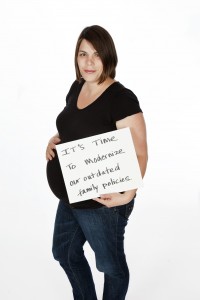 When Janet’s second baby was born she took a seven-week unpaid maternity leave made possible by the now 21-year-old Family and Medical Leave Act (FMLA). Seven weeks. It’s all she could afford. Just the week before she returned to work Janet hemorrhaged due to a retained placenta and lost a third of her blood. She was weak and needed more time at home to recover, but she just couldn’t afford to be away from work any longer.
When Janet’s second baby was born she took a seven-week unpaid maternity leave made possible by the now 21-year-old Family and Medical Leave Act (FMLA). Seven weeks. It’s all she could afford. Just the week before she returned to work Janet hemorrhaged due to a retained placenta and lost a third of her blood. She was weak and needed more time at home to recover, but she just couldn’t afford to be away from work any longer.
Two and a half times as many people as in 2000 need leave and are not taking it, chiefly because they cannot afford it.
Tessa and her husband had a plan when their first baby was born. As a school employee she qualified for family leave under the Family and Medical Leave Act (FMLA), and the Oregon state law that expands protections to even more working parents (the Oregon Family Leave Act). They saved up. They planned to bank vacation and sick days during her pregnancy so they might stretch some paid days into their unpaid family leave time. They worked with their employers to figure out a family schedule that would allow them to stagger their time away from work. But all that planning fell apart when Tessa was put on bed rest a few months before her baby was due. It was further compromised when her baby was born prematurely. He spent his first 2 weeks in the NICU and required ongoing respiratory treatments during his first year of life.
Tessa took the full amount of unpaid leave she had access to under the FMLA, and some of the additional (unpaid) sick child leave that is provided for under Oregon law. She felt lucky to have job protection during this stressful time, but her unexpected need for extended leave took a toll on their family finances. They got behind on bills, had unanticipated health and child care costs, and were forced to rely on much less income for much longer than expected. It took years after their son’s birth for Tessa and her husband to dig themselves out of the debt they incurred when their child was born.
A quarter of all American poverty spells – when a family falls into poverty for at least 2 months – begin with the birth of a new child.
Amy had her first baby when she and her husband were living in Mexico. Even as an American teacher working abroad Amy was able to take 3-months of paid maternity leave under Mexican law – paid at her full salary. A few years later, when she was back to teaching in an American school, she found out she was pregnant with her second child. When she inquired about maternity leave she found out that, due to job tenure requirements, she barely qualified for unpaid parental leave under FMLA. She was shocked. How was it that Mexico offered new mothers better options after a child is born than mothers have in the United States?
Only 60% of American workers, and just about one-fifth of all new mothers, are covered by FMLA due to part-time status, size of employer, or length of job tenure.
The Family and Medical Leave Act was an important first step in acknowledging something working families have long known: occasionally most of us need time away from work to care for a loved one or to recover from illness. But the step we took as a nation 21 years ago hasn’t kept pace with the changing needs of our workforce or our families.
At the moments in life when people need family leave most they are usually least equipped to deal with periods without pay. Creating a paid family leave program that allows all workers this time – without creating economic instability – just makes good sense. It’s time for us to take this important leap forward.
Visit the Family Values @ Work carnival blog page for reflections on FMLA from other activists around the country.

